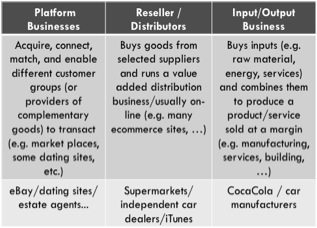Since we declared our love to platform businesses in a previous post it is only fair for us to try to provide a definition of what we mean by platforms before explaining in more detail why we love them.
A plank, a raised floor, Lady Gaga’s favourite accessory…
The apparently innocuous question around the definition of “platforms” raises in fact many issues. The traditional definitions of the term are not overly helpful and even its business usage seems to be loosely used in the context of “something upon which you can build something else”.
It is in this latter context that a manufacturer would for example say that “the Jaguar X type uses the same platform as the Ford Mondeo”. This is a very generic use of the term and we believe we need to think through a more precise definition for what we refer to as “platform business model” like eBay or others.
Comparing business models: Producing &, Distributing vs. Connecting?
In order to better understand the characteristics of what we call platform businesses it is helpful to compare and contrast them with other traditional business models.
Everybody knows and understands what we call “input/output” businesses… these are simply traditional “linear” businesses usually buying raw material (inputs), transforming and combining them is a value adding way as part of the production process and selling the end product (output) at (hopefully) more than costs.
This (arguably large) category of businesses which includes most manufacturers and even services companies (we don’t like it but economists see consultants as raw material) is at the heart of management sciences today and what is taught in business school.
Another type of business, often complementary to the “input/output” business is the distribution centric business. Distribution is arguably a subset of the traditional “input/output” business and these can be vertically integrated. Other times distribution businesses are stand-alone and acquire products that they resell and distribute for a margin. Independent car dealers or retail stores are typical distributors.
Three different business models
Platforms: businesses connecting different customer groups for them to transact.
Business models belonging to the last category that we call platforms don’t produce anything and don’t distribute other goods or services. What they do is connect different customer groups to enable transactions. Think about eBay and the value it creates in connecting buyers and sellers for a wide variety of goods.
These platform businesses typically create value by:
i) acquiring a critical mass of customers in each group (e.g. buyers AND sellers on eBay);
ii) matching them through (e.g. through a search interface in eBay’s example);
iii) connecting them so that they can exchange (e.g. ask questions on goods before buying);
iv) enabling a transaction so that purchase can be made (e.g. goods paid for and sent on eBay).
Often online platforms can optimise their entire process in near real time thanks to built in big data feedback models. If there is a bottleneck forming at one of the stages of value creation then management attention can almost immediately focus on what the issue might be. Please note that traditional marketplaces or even estate agents are types of off-line platforms that have existed for centuries but while the principles of the business models are not knew technology is enabling them to address high growth markets like never before.
The definition proposed above works well for our purpose but in real life we further sub segment the platform category in order to account for different flavours of platforms. But before we do this in our next post here is a little exercise for you… the next chart shows the top 60 global brands by value[1] (the ranking is actually quite correlated with market cap). The ones with a large logo have grown by more than 25% last year… now let’s see if you can find the platform ones?
We’ll try to identify the platform firms in our next post, propose some helpful sub categories and introduce the concept of platform ecosystems.



4 comments on “What is a platform business?”
Comments are closed.